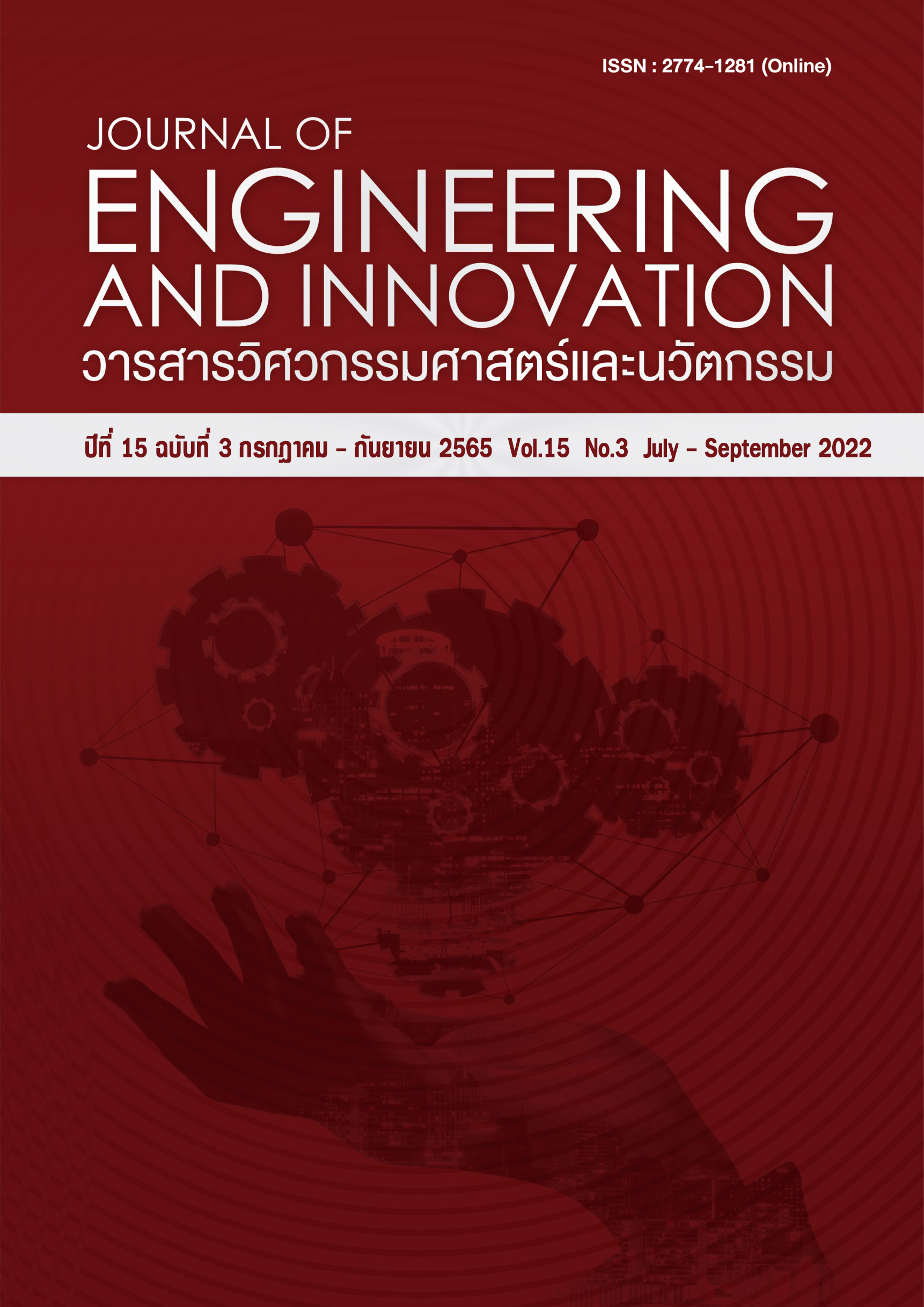Effect of Impeller Rotating Speed of Sludge Recirculation Clarifier on Turbidity Removal Efficiency for Water Treatment Plant
Main Article Content
Abstract
This paper aims to study the turbidity removal efficiency of sludge recirculation clarifier when changing impeller rotating speed. The alum dosing rates of 13, 17 and 21 mg/l and production rates of 2.2, 2.4 and 2.6 cubic meter per second (cms) were applied in the study. The effect of optimized impeller rotating speeds corresponded to the best turbidity removal efficiency. Experimental results found that the relationship between the impeller rotating speeds and turbidity removal efficiency tended to in the third order polynomial equation. In the range of 1.3-1.6 rpm of impeller rotating speeds, the turbidity removal efficiencies were relatively low. In the range of 1.6-2.0 of impeller rotating speeds, the turbidity removal efficiencies were increased with impeller rotating speeds. The increased impeller rotating speeds from 2.0 to 2.2 rpm resulted in relatively low of turbidity removal efficiencies. The increased impeller rotating speeds could possibly induce the sludge collision, thus decreasing sludge size. In addition, the alum dosing rates and production rates were also affected with turbidity removal efficiencies. The optimum conditions caused by 17 mg/l of alum dosing rate, 2.4 cms of production rate and 1.9-2.1 rpm of Impeller rotating speeds provided high turbidity removal efficiencies of 89.4±1.18%.
Article Details
References
American Water Works Association (AWWA), American Society of Civil Engineer (ASCE). Water treatment plant design. 4th ed. New York: McGRAW-Hill; 2005.
Dorea CC. Coagulant-based emergency water treatment. Desalination. 2009;248: 83-90.
Twort AC, Ratnayaka DD, Brandt MJ. Water supply. 5th ed. Oxford; Butterworth-Heinemann; 2011.
ญานิศา ตันติปาลกุล, คุณัช ปาลวัฒน์วิไชย, ธิดารัตน์ เดชฉกรรจ์ และ เขมจิรา ไขสาร. การศึกษาสารตกตะกอนที่เหมาะสมสำหรับกระบวนการผลิตน้ำประปา การประปานครหลวง. วารสารวิทยาศาสตร์บูรพา 2561; 23(1):207-220.
ชัยวัฒน์ ชมสุวรรณ์. การปรับปรุงประสิทธิภาพการกำจัดความขุ่นของถังตกตะกอนในกระบวนการผลิตน้ำประปา. วิทยานิพนธ์ สาขาวิศวกรรมอุตสาหการ ภาควิชาวิศวกรรมอุตสาหการ มหาวิทยาลัยเกษตรศาสตร์. 2552.
โสภณ เอียดประพาล. การศึกษาเกณฑ์การควบคุมและประสิทธิภาพของถังกำจัดความขุ่นแบบใช้ชั้นตะกอนในระบบปรับคุณภาพน้ำ โรงงานผลิตน้ำประปาแพงพวย จังหวัดราชบุรี. วิทยานิพนธ์ สาขาวิศวกรรมสิ่งแวดล้อม ภาควิชาวิศวกรรมสิ่งแวดล้อม มหาวิทยาลัยเกษตรศาสตร์. 2545.
ลัดดา ธรรมการัณย์. ผลของใบพัดต่อการกำจัดความขุ่นด้วยถังทำน้ำใสแบบหมุนเวียนตะกอน. วิทยานิพนธ์ สาขาวิศวกรรมสิ่งแวดล้อม ภาควิชาวิศวกรรมสิ่งแวดล้อม จุฬาลงกรณ์มหาวิทยาลัย; 2536.
วิจารณ์ ตันติธรรม. การกำจัดความขุ่นแบบถังทำน้ำใสแบบหมุนเวียนตะกอน. วิทยานิพนธ์ สาขาวิศวกรรมสิ่งแวดล้อม ภาควิชาวิศวกรรมสิ่งแวดล้อม จุฬาลงกรณ์มหาวิทยาลัย; 2537.
Zhang Z, Liu D, Hu D, Li D, Ren X, Cheng Y, Luan Z. Effect of Slow-Mixing on the Coagulation Performance of Polyaluminum Chloride(PACl). Chinese Journal of Chemical Engineering. 2013;21(3): 318-323.
สุรัตน์ อินทร์โต. ผลของอัตราพัลเซชั่น อัตราน้ำล้นผิวและระยะยกของน้ำในหอสุญญากาศต่อประสิทธิภาพการลดความขุ่นของถังตกตะกอนแบบพัลเซชั่นแคลริฟายเออร์. วิทยานิพนธ์ สาขาเทคโนโลยีสิ่งแวดล้อม ภาควิชาวิทยาศาสตร์ มหาวิทยาลัยมหิดล; 2548.
Ghawi AH, Jasem YI. Optimization of the Horizontal Sedimentation Tank to Predict Turbidity Removal Efficiency in Water Treatment Plant in Iraq. Diyala Journal of Engineering Sciences. 2018;11(1): 33-37.
ทวีศักดิ์ วังไพศาล. วิศวกรรมการประปา. พิมพ์ครั้งที่ 2. กรุงเทพฯ: สำนักพิมพ์แห่งจุฬาลงกรณ์มหาวิทยาลัย; 2557.
Davis ML. Water and Wastewater Engineering: Design Principles and Practice. New York: McGRAW-Hill; 2010.
พลอยไพลิน ร่มโพธิ์ภักดิ์. การกำจัดความขุ่นด้วยถังตกตะกอนสัมผัสแบบหมุนเวียนตะกอน. วิทยานิพนธ์ สาขาวิศวกรรมสิ่งแวดล้อม ภาควิชาวิศวกรรมสิ่งแวดล้อม จุฬาลงกรณ์มหาวิทยาลัย; 2556.
Hurst MW. Evaluation of Parameters Affecting Steady-state Floc Blanket Performance. Dissertation Environmental science, Cornell University; 2010.

